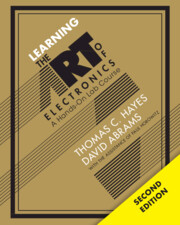Book contents
- Learning the Art of Electronics
- Learning the Art of Electronics
- Copyright page
- Dedication
- Contents
- Preface to the Second Edition
- Preface to the First Edition
- Overview, as the Course begins
- Part I Analog: Operational Amplifiers and their Applications
- Part II Analog: Discrete Transistors
- Part III Analog: Operational Amplifiers and their Applications
- Part IV Digital: Gates, Flip-Flops, Counters, PLD, Memory
- 14N Logic Gates
- 14L Lab: Logic Gates
- 14S Supplementary Notes: Digital Jargon and Logic Interfacing
- 14W Worked Examples: Logic Gates
- 14O Online Content: Logic Gates
- 15N Introduction to Programmable Logic
- 15L Lab: Programmable Logic
- 15S Supplementary Notes: The WebFPGA
- 15W Worked Examples: Programmable Logic
- 15O Online Content: Programmable Logic
- 16N Flip-Flops
- 16L Lab: Flip-Flops
- 16S Supplementary Notes: Flip-Flops
- 17N Counters
- 17L Lab: Counters
- 17S Supplementary Notes: Digital Debugging
- 17W Worked Examples: Applications of Counters
- 17O Online Content: Counters
- 18N Memory
- 18L Lab: Memory
- 18S Supplementary Notes: Memory Blocks
- 19N Finite State Machines
- 19L Lab: Finite State Machines
- 19W Worked Examples: Finite State Machines
- Part V Digital: Analog–Digital, PLL, Digital Project Lab
- Part VI Microcontrollers
- Book part
- Index
14S - Supplementary Notes: Digital Jargon and Logic Interfacing
from Part IV - Digital: Gates, Flip-Flops, Counters, PLD, Memory
Published online by Cambridge University Press: 18 March 2025
- Learning the Art of Electronics
- Learning the Art of Electronics
- Copyright page
- Dedication
- Contents
- Preface to the Second Edition
- Preface to the First Edition
- Overview, as the Course begins
- Part I Analog: Operational Amplifiers and their Applications
- Part II Analog: Discrete Transistors
- Part III Analog: Operational Amplifiers and their Applications
- Part IV Digital: Gates, Flip-Flops, Counters, PLD, Memory
- 14N Logic Gates
- 14L Lab: Logic Gates
- 14S Supplementary Notes: Digital Jargon and Logic Interfacing
- 14W Worked Examples: Logic Gates
- 14O Online Content: Logic Gates
- 15N Introduction to Programmable Logic
- 15L Lab: Programmable Logic
- 15S Supplementary Notes: The WebFPGA
- 15W Worked Examples: Programmable Logic
- 15O Online Content: Programmable Logic
- 16N Flip-Flops
- 16L Lab: Flip-Flops
- 16S Supplementary Notes: Flip-Flops
- 17N Counters
- 17L Lab: Counters
- 17S Supplementary Notes: Digital Debugging
- 17W Worked Examples: Applications of Counters
- 17O Online Content: Counters
- 18N Memory
- 18L Lab: Memory
- 18S Supplementary Notes: Memory Blocks
- 19N Finite State Machines
- 19L Lab: Finite State Machines
- 19W Worked Examples: Finite State Machines
- Part V Digital: Analog–Digital, PLL, Digital Project Lab
- Part VI Microcontrollers
- Book part
- Index
Summary
Defines the level (high or low) in which a signal is “True,” or – better – “Asserted” (see next term). We avoid the former because many people associate “True” with “High,” and that is an association we must break.
- Type
- Chapter
- Information
- Learning the Art of ElectronicsA Hands-On Lab Course, pp. 601 - 605Publisher: Cambridge University PressPrint publication year: 2025

